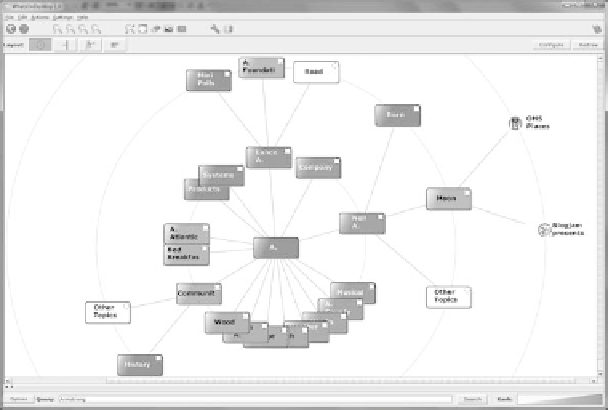Biomedical Engineering Reference
In-Depth Information
the list of results, which can be very long. IVA changes this critical operation. Traditionally,
search engine results are presented as a list of pages that are sequentially scanned. An
alternative presentation could be the following: pages are grouped into different catego-
ries, in which each category contains pages that are semantically coherent; furthermore,
possible relations between different categories are explicitly showed. In this scenario, the
number of commands associated with the browsing can be significantly reduced because
the information space to be searched by the end-user looking for a page is naturally nar-
rowed by selecting categories or subcategories and by discarding large quantities of unin-
teresting pages with a single command. A snapshot of a possible diagrammatic interface
for this specific operation is given in Figure 16.2, which represents the output of a visual
web search engine called WhatsOnWeb (Di Giacomo et al. 2007).
16.2.3.1 The Application Information Visualization Approach:
The Web Accessibility for Disabled Users
We propose a new interaction paradigm between computers and disabled users. The
objective is both to make the impaired people capable of using a computer in a more effi-
cient way and to take advantage of this gained efficiency in an aid assessment process
that exploits the Web to easily convey information of any kind to impaired people. The
leading idea is that the use of sophisticated information visualization technologies can
significantly affect the cognitive efficiency of a user that browses the Web, even if this user
is blind (Di Giacomo et al. 2010). Information visualization conveys abstract information
in intuitive ways. Visual representations and interaction techniques take advantage of the
human eye's broad bandwidth pathway into the mind to allow users to see, explore, and
understand large amounts of information at once. Furthermore, it has been shown that
spatial representation can be independent by the sensorial way in which it is perceived
(Avraamides et al. 2004), leading to the hypothesis of an amodal spatial representation
(Bryant 1992). The screen readers are an effective solution for several software applica-
tions adapted by blind people. However, because the quantity of nontextual conveyed
FIgUre 16.2
(See color insert.)
Example of diagrammatic interface that reduces the search commands to be executed when
accessing a page on the Web.

